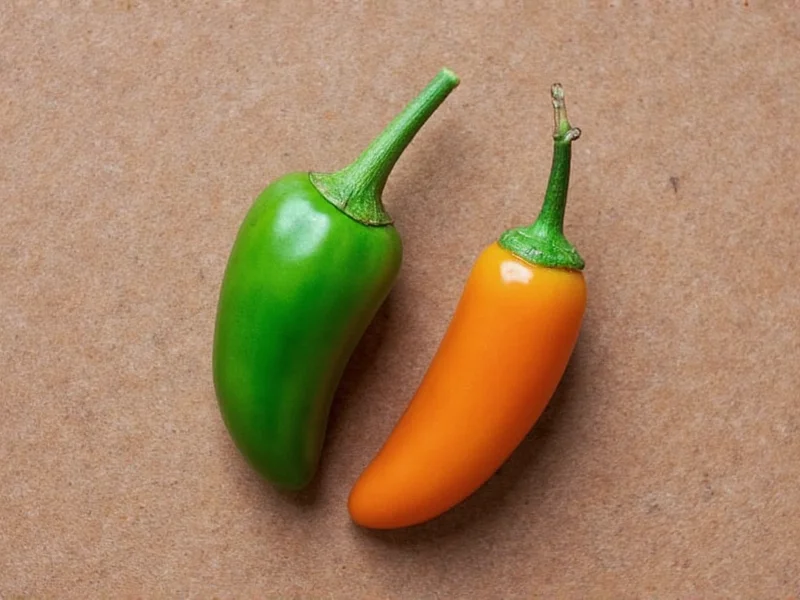When comparing serrano vs jalapeño heat, understanding the Scoville scale is essential for making informed culinary decisions. The Scoville scale measures chili pepper pungency (spiciness or 'heat') by determining capsaicin concentration. While both peppers belong to the Capsicum annuum species, their heat levels differ substantially due to genetic variations and growing conditions.
Understanding Serrano Pepper Heat Characteristics
Serrano peppers deliver a sharp, immediate heat that builds quickly. These 1-4 inch long peppers typically register between 10,000-23,000 Scoville units, though some specimens can reach up to 30,000 SHU under optimal growing conditions. The heat is concentrated in the white pith and seeds, with the thinnest-walled varieties often being the hottest.
Grown primarily in mountainous regions of Mexico (where "serrano" means "from the mountains"), these peppers have a bright, grassy flavor that complements their intense heat. Their smooth, firm skin makes them ideal for roasting, pickling, or using fresh in salsas where you want pronounced heat without excessive bulk.
Jalapeño Pepper Heat Profile Explained
Jalapeños, named after the Mexican city of Xalapa, provide a more moderate heat experience at 2,500-8,000 Scoville units. This places them firmly in the medium-heat category, making them accessible to most palates while still delivering noticeable spice. The heat builds more gradually than serranos and often includes subtle sweet, vegetal notes.
These 2-3.5 inch peppers develop characteristic brown "corking" lines as they mature, which often indicates increased heat levels. Unlike serranos, jalapeños have thicker walls, making them perfect for stuffing, smoking (becoming chipotles), or adding to dishes where you want pepper presence without overwhelming heat.
Direct Comparison: Serrano vs Jalapeño Heat Levels
| Characteristic | Serrano Pepper | Jalapeño Pepper |
|---|---|---|
| Scoville Heat Units | 10,000-23,000 SHU | 2,500-8,000 SHU |
| Relative Heat | 2-4 times hotter | Baseline for comparison |
| Heat Onset | Immediate, sharp burn | Gradual build-up |
| Flavor Profile | Bright, grassy, clean heat | Sweet, vegetal, earthy |
| Pepper Wall Thickness | Thin | Thick |
| Common Culinary Uses | Salsas, hot sauces, garnishes | Stuffing, pickling, nachos, poppers |
Practical Implications for Cooking
Understanding the serrano vs jalapeño heat difference is crucial for recipe success. When substituting one for the other, remember that one serrano pepper typically equals 2-3 jalapeños in heat intensity. For those sensitive to spice, serranos require more careful handling—always wear gloves when seeding and chopping to avoid skin irritation.
Chefs often choose serranos when they want pure heat without altering texture, as their thin walls virtually disappear in cooked dishes. Jalapeños shine when you want the pepper itself to be a featured ingredient, whether stuffed with cheese, pickled for cocktails, or smoked for chipotle flavor. The visual differences between serrano and jalapeño peppers also matter—serranos grow upright on the plant and are typically straighter, while jalapeños hang downward and often curve slightly.
When to Choose Serrano Over Jalapeño (and Vice Versa)
Select serrano peppers when you need:
- Intense heat without bulk in salsas and hot sauces
- A cleaner, brighter pepper flavor
- Peppers for quick-cooking applications
- Higher heat for preserving (pickled serranos pack more punch)
- Milder heat for family-friendly dishes
- Thicker peppers for stuffing or grilling
- Sweetness to balance other flavors
- Peppers that maintain structure during cooking
Substitution Guide for Serrano vs Jalapeño Heat
When substituting serranos for jalapeños, use approximately half the quantity called for in the recipe. For example, if a recipe requires two jalapeños, start with one serrano and adjust to taste. Conversely, when replacing serranos with jalapeños, you'll typically need 2-3 jalapeños for each serrano.
Remember that heat levels vary within each pepper type based on growing conditions, so always taste a small piece before adding to your dish. Removing seeds and white membranes reduces heat significantly for both varieties, though this affects serranos more dramatically due to their higher capsaicin concentration in these areas.
FAQ Section
How much hotter is a serrano than a jalapeño?
Serrano peppers are typically 2-4 times hotter than jalapeños. While jalapeños measure 2,500-8,000 Scoville Heat Units (SHU), serranos range from 10,000-23,000 SHU. This means one serrano pepper generally equals 2-3 jalapeños in heat intensity, making serranos significantly hotter for those sensitive to spice.
Can I substitute serrano for jalapeño in recipes?
Yes, but use approximately half the quantity of serranos compared to jalapeños. For example, if a recipe calls for two jalapeños, start with one serrano and adjust to taste. Remember that serranos deliver heat more immediately while jalapeños have a gradual build-up, so the substitution affects both heat level and flavor experience.
What's the visual difference between serrano and jalapeño peppers?
Serrano peppers are typically straighter, thinner-walled, and grow upright on the plant, while jalapeños often have a slight curve, thicker walls, and hang downward. Serranos are usually 1-4 inches long compared to jalapeños' 2-3.5 inches. Jalapeños develop characteristic brown "corking" lines as they mature, which serranos rarely show.
Which pepper is better for making hot sauce: serrano or jalapeño?
Serranos are generally preferred for hot sauces requiring intense heat with clean pepper flavor, as their thin walls blend smoothly and deliver consistent heat. Jalapeños work better for milder sauces where you want to preserve some pepper texture and sweetness. Many hot sauce makers blend both to achieve balanced heat with complex flavor profiles.
Do serrano and jalapeño peppers have different flavor profiles beyond heat?
Yes, serranos have a brighter, grassier flavor with clean heat, while jalapeños offer more sweetness and earthiness with their milder heat. Serranos provide a sharper, more immediate burn that doesn't linger as long, whereas jalapeños have a gradual heat build-up with subtle vegetal notes. These flavor differences significantly impact how each pepper performs in various culinary applications beyond just their heat level.











 浙公网安备
33010002000092号
浙公网安备
33010002000092号 浙B2-20120091-4
浙B2-20120091-4